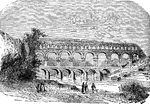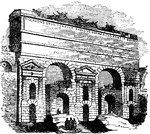Clipart tagged: ‘aqueduct’

Aqueduct
"A conduit for conveying water more particularly applied to structures for conveying water from distant…

Aqueduct
This image depicts a market in front of The Aqueduct of Segovia, located in Segovia, Spain. It was built…

Pont du Gard
The Pont du Gard is an aqueduct and bridge that was built over the Gard River by the Roman Empire. It…

A Roman Aqueduct
"The Pont du Gard near Nimes (ancient Nemausus) in southern France. Built by the emperor Antoninus Pius.…

Collection of Sewer Cross-Sections
"A conduit or canal constructed, especially in a town or city, to carry off superfluous, water, soil,…


